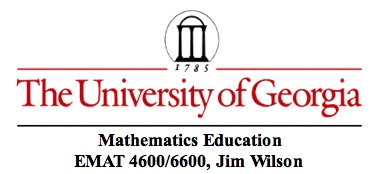


Estimate the area of Texas, in square miles, given the following map and the indicated scale. We will use the same map and scale in miles on the subsequent problems.
Click HERE for a GSP file containing the map and scale to facilitate measurements. There is, of course, issues of accuracy with such a rough map and scale, but the goal is making "reasonable" estimates. More careful and accurate instruments might be used if level of precision were the issue.
Some thought on possible range of estimates might be useful. For example, looking at the scale, we might visualize a circle with a radius of about 300 miles and locate its center somewhere in the middle. NOT precise but it would tell us the area was somewhere around 282,000 sq. miles when we multiply 3.14 (300)(300)
Discussion items:
How else might we estimate the area of this irregular shape? If you have a proposal, write down the procedure and carry through to get an estimate.
Some examples that have come up.
A. Take a string and lay it along the outline. Then when completed, measure the string, divide by 4, and square the get an estimate of the area. (Try it.) Taking a square that has the same perimeter as the irregular shape is not so bad for rough estimate.
B. Move the string until it forms a circle and then find the area of that.
C. Find the smallest rectangle that includes all of the map, take the largest rectangle that fits entirely within the state and take the average of the areas. This is shown below.
D. Same as C, but with circles.
E. Cover the map with a grid and count the squares on the grid . . .
F. Same as E, but count those entirely within the map, count those on the border, and . . . like we did in grade school . . .
Each of these strategies provides an opportunity (and a need) for clarifying some ideas about area and about estimates of area. Each provide an opportunity for questions such as
a. Why is his a reasonable estimate?
b. Would the procedure work for the map of another state? For example, would the perimeter stuff work as well for California?
c. How would you change your procedure to get a better estimate?
Suggestion F, of course has been a part of elementary school textbooks for years and different variations of it are intended to obtain an inner measure and an outer measure and estimate the area of the irregular shape by the arithmetic mean of the inner area and the outer area. More precision could come from using a finer grid. Using the scale provided with the map, each unit square is 60 miles on each side.
A strategy of inner and outer rectangles is illustrated at the right. It has the drawback of no obvious way to improve the estimate. In this case it is pretty clear that this procedure would produce an over-estimate. The inner measure is 25 sq. units and the outer measure is 156.12 sq. units. The arithmetic mean of this two measures. Taking the arithmetic mean and multiplying by 3600 gives approximately 316,480 sq. miles.
Strategies adapted from the Golf Green Area problem could be used by considering the map and the scale provided. Here is a set of 8 measures from a central point to the border. The first estimate formula from the Golf Green Area problem would give the following calculation -- readily available with a calculator. Each unit in the drawing represents 60 miles. Therefore the coversion to square miles needs to be applied to this calculation.
The measures indicated on the map are units from the given scale. Each unit represents 60 miles. The sum of the 8 measurs is approximately 40 (not exactly, but we are doing an estimate). Now 40 / 8 = 5 and the Area esimate is π(5)(5)(3600) = 282,600 sq. miles. Or not rounding to 5, the sum divided by 8 is 4.75. So the areas estimate is π(4.7)(4.7)(3600) = 255.047 sq. mi.
There are many sources of approximation in any estimation procedure. For instance, the map as drawn is not so precise. The scale is certainly an approximation and using it as a measure is a reason for understanding why we are getting an estimate rather than doing a precise calculation. Also, the 8 measures here may have considerable potential for error as well. The actual area is 268,820 square miles.
The alternate formula from the Golf Greens Area problem can be compared here. Do you get 266,789 sq. miles?
